|
|
|
|
|
|
|
|
|
|
|
|
New CaledoniaMelanesia - Pacific Ocean
Other pages in my New Caledonia series
New Caledonia (French: Nouvelle-Calédonie; popular names: Kanaky, Le caillou), is a "sui generis collectivity" (in practice an overseas territory) of France, made up of a main island (Grande Terre), the Loyalty Islands, and several smaller islands. It is located in the region of Melanesia in the southwest Pacific. At about half the size of Taiwan, it has a land area of 18,575.5 square kilometres (7,172 sq mi). The population was 244,600 inhabitants as of January 2008 official estimates. The capital and largest city of the territory is Nouméa. The currency is the CFP franc. Since 1986 the United Nations Committee on Decolonisation has included New Caledonia on the United Nations list of Non-Self-Governing Territories. New Caledonia will decide whether to remain within the French Republic or become an independent state in a referendum sometime after 2014. Its capital Nouméa is the seat of the regional organization, the Secretariat of the Pacific Community (formerly the South Pacific Commission). Origin of the name The name Caledonia derives from the Latin name of an area corresponding to modern Scotland. The name Kanaky is also in common usage in French, English and the indigenous languages. This name is favoured by Melanesian nationalists. The word comes from kanaka, a Hawai`ian word (elsewhere tangata and variants) meaning "human/person/people", used by Polynesians to refer to themselves. The word was later used by the French about all the indigenous inhabitants of the South Pacific Ocean, including the Melanesian (non-Polynesian) native inhabitants of New Caledonia. The word, turned into Canaque in French, became derogatory. In the 1960s and 1970s, when the Melanesian native inhabitants started to organize themselves into political parties and call for independence, the word was transformed into a symbol of political emancipation and pride. In 1983, during the period of political turmoil, the terms Kanak and Kanaky became political brand names and colonial whites which realized the name had changed into a political statement. History The western Pacific was first populated about 50,000 years ago. The Austronesians moved into the area later. The diverse group of people that settled over the Melanesian archipelagos are known as the Lapita. They arrived in the archipelago now commonly known as New Caledonia and the Loyalty Islands around 1500 BC. The Lapita were highly skilled navigators and agriculturists with influence over a large area of the Pacific. 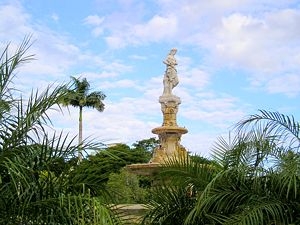 Fountain Celeste - Noumea Europeans first sighted New Caledonia and the Loyalty Islands in the late 18th century. The British explorer James Cook sighted Grande Terre in 1774 and named it New Caledonia, Caledonia being the Latin name for Scotland. During the same voyage he also named the islands to the north of New Caledonia the New Hebrides (now Vanuatu), after the islands north of Scotland. Whalers operated off New Caledonia during the 19th century. Sandalwood traders were welcome but as supplies diminished, the traders became abusive. The Europeans brought new diseases such as smallpox, measles, dysentery, influenza, syphilis and leprosy. Many people died as a result of these diseases. Tensions developed into hostilities and in 1849 the crew of the Cutter were killed and eaten by the Pouma clan. As trade in sandalwood declined it was replaced by a new form of trade, Blackbirding. Blackbirding was a euphemism for enslaving people from New Caledonia, the Loyalty Islands, New Hebrides, New Guinea and the Solomon Islands to work in sugar cane plantations in Fiji and Queensland. The trade ceased at the start of the 20th century. The victims of this trade were called Kanakas, a label later shortened to Kanak and adopted by the indigenous population after French annexation. The island was made a French possession in late 1853 in an attempt by Napoleon III to rival the British colonies in Australia and New Zealand. Following the example set by the British in nearby Australia, between 1864 and 1922 France sent a total of 22,000 convicted felons to penal colonies along the south-west coast of the island; this number includes regular criminals as well as political prisoners such as Parisian socialists and Kabyle nationalists. Towards the end of the penal colony era, free European settlers (including former convicts) and Asian contract workers by far out-numbered the population of forced workers. The indigenous Kanak populations declined drastically in that same period due to introduced diseases and an apartheid-like system called Code de l'Indigénat which imposed severe restrictions on their livelihood, freedom of movement and land ownership. During World War II, US and Allies forces built a major position in New Caledonia to combat the advance of Japan in South-East Asia and toward Australia. Noumea served as a headquarters for the United States military in the Pacific. The proximity of the territory with the South Pacific operations permitted also quick repairs in Noumea of damaged US ships. The American 23rd Infantry Division is still unofficially named Americal, the name being a contraction of "America" and "New Caledonia". The U.S. military headquarters - a pentagonal complex - was, after the war, taken over as the base for a new regional intergovernmental development organisation: the South Pacific Commission, later known as the Secretariat of the Pacific Community. New Caledonia has been on a United Nations list of non-self-governing territories since 1986. Agitation by the Front de Libération Nationale Kanak Socialiste (FLNKS) for independence began in 1985. The FLNKS (led by the late Jean-Marie Tjibaou, assassinated in 1989) advocated the creation of an independent state of 'Kanaky'. The troubles culminated in 1988 with a bloody hostage taking in Ouvéa. The unrest led to agreement on increased autonomy in the Matignon Accords of 1988 and the Nouméa Accord of 1998. This Accord describes the devolution process as "irreversible" and also provides for a local Caledonian citizenship, separate official symbols of Caledonian identity (such as a "national" flag), as well as mandating a referendum on the contentious issue of independence from the French Republic sometime after 2014. Politics The unique status of New Caledonia is in between that of an independent country and a normal Overseas department of France.  Flag of the independence movements Key areas (e.g. taxation, labour law, health and hygiene, foreign trade, and others) are already in the hands of the Territorial Congress and government. Further authority will be given to the Territorial Congress in the near future. Ultimately, the French Republic should only remain in charge of foreign affairs, justice, defense, public order, and treasury. An additional enhancement to New Caledonian autonomy has come in the form of recently-introduced territorial "citizenship": Only New Caledonian "citizens" have the right to vote in local elections. The introduction of this right has been criticised, because it creates a second-class status for French citizens living in New Caledonia who do not possess New Caledonian "citizenship" (because they settled in the territory recently). Further signs of increased autonomy for the territory, include New Caledonia's right to engage in international cooperation with independent countries of the Pacific Ocean region, the continued use of a local currency (the French Pacific Franc, or CFP) rather than the Euro, as well as the authority of the Territorial Congress to pass statutes overriding French law in a certain number of areas. On the other hand, New Caledonia remains a part of the French Republic. The inhabitants of New Caledonia are French citizens and carry French passports. They take part in the legislative and presidential French elections, sending two representatives to the French National Assembly and one senator to the French Senate. At the 2007 French presidential election the voter turnout in New Caledonia was 68.14%. The representative of the French central state in New Caledonia is the High Commissioner of the Republic (Haut-Commissaire de la République, locally known as "haussaire"), who is the head of civil services, and who sits as an integral part of the territorial government. The Nouméa Accord provides a mechanism for the determination of the ultimate status and degree of New Caledonian territorial autonomy: Pursuant to the Accord, the Territorial Congress will have the right to call for a referendum on independence, at any time of its choosing after 2014. The current president (2008) of the government elected by the territorial Congress is Harold Martin, from the loyalist (i.e. anti-independence) "Future Together" party (l'Avenir Ensemble), which crushed the long-time ruling RPCR (Rally for Caledonia in the Republic) in May 2004. "Future Together" is a party of mostly White and Polynesian New Caledonians opposed to independence, but rebelling against the hegemonistic and (allegedly) corrupt anti-independence RPCR, led by the now-discredited Jacques Lafleur. Their toppling of the RPCR (that was until then seen as the only voice of New Caledonian Whites) was a surprise to many, and a sign that New Caledonian society is undergoing changes. "Future Together," as the name implies, is opposed to a racial-oriented vision of New Caledonian political life, one based purely on the political primacy of either the Melanesian native inhabitants or the descendants of European settlers. Rather, it is in favour of a multicultural New Caledonia, of governing principles that better reflect the reality of the existence of large populations of Polynesians, Indonesians, Chinese, and other immigrant communities that make up the territory's population. Some members of "Future Together" are even in favour of independence, though not necessarily on the same basis as the Melanesian independence parties. Representation at the national level New Caledonia sends two deputies to the French National Assembly, one representing the commune (municipality) of Nouméa, the commune of L'Île-des-Pins and the Loyalty Islands Province, and the other representing the rest of New Caledonia. New Caledonia also sends one senator to the French Senate.  New Caledonia map from CIA World Factbook New Caledonia map from CIA World Factbook New Caledonia is located around 21°30'S, 165°30'E in the southwest Pacific Ocean, approximately 1,200 kilometres (746 mi) east of Australia and 1,500 kilometres (932 mi) northwest of New Zealand. The island nation of Vanuatu lies to the northeast. New Caledonia is made up of a main island, the Grande Terre, and several smaller islands, the Belep archipelago to the north of the Grande Terre, the Loyalty Islands to the east of the Grande Terre, the Île des Pins to the south of the Grande Terre, the Chesterfield Islands and Bellona Reefs further to the west. The Grande Terre is by far the largest of the islands, and the only mountainous island. It has an area of 16,372 square kilometres (6,321 sq mi), and is elongated northwest-southeast, 350 kilometres (217 mi) in length and 50 to 70 kilometres (31-44 mi) wide. A mountain range runs the length of the island, with five peaks over 1,500 meters (4,900 ft). The highest point is Mont Panié at 1,628 meters (5,341 ft) elevation. The total area of New Caledonia is 19,060 square kilometers (7,359 sq mi), 18,575 square kilometers (7,172 sq mi) of those being land. 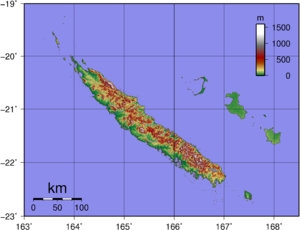 Topographic map of New Caledonia It sank after rifting away from Australia 60-85 million years ago (mya) and from Antarctica between 130 and 85 mya. New Caledonia itself is separated from Australia since 65 mya, and subsequently drifted in a north-easterly direction, reaching its present position about 50 mya. Subdivisions Along with other Pacific Ocean territories of French Polynesia and Wallis and Futuna, New Caledonia is part of the French Republic. Its official status, unique in the French Republic, is said to be sui generis, because New Caledonia is the only French subdivision that is not a collectivité territoriale. New Caledonia was a colony until 1946, then an overseas territory (territoire d'outre-mer, or TOM) from 1946 to 1999. The capital is Nouméa, the only major conurbation in the territory. 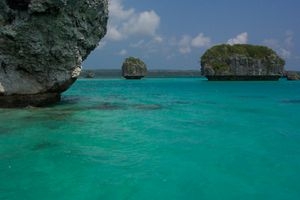
Île des Pins * South Province (province Sud). Provincial capital: Nouméa. Population: 164,113 inhabitants (2004). * North Province (province Nord). Provincial capital: Koné. Population: 44,596 inhabitants (2004). * Loyalty Islands Province (province des îles Loyauté). Provincial capital: Lifou. Population: 22,080 inhabitants (2004). It is further subdivided into thirty-three communes. One commune, Poya, is divided between two provinces. The northern half of Poya, with the main settlement and most of the population, is part of the North Province, while the southern half of the commune, with only 122 inhabitants in 2004, is part of the South Province. There are also three administrative subdivisions, simply known as subdivisions in French, with exactly the same names and same boundaries as the three provinces, except that the commune of Poya is entirely contained inside the North Subdivision. 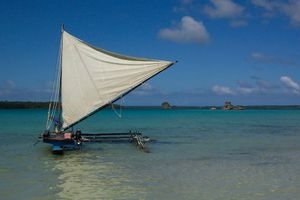
Piroque Île des Pins New Caledonia lies astride the Tropic of Capricorn, between 19° and 23° south latitude. The climate of the islands is tropical, and rainfall is highly seasonal, brought by trade winds that usually come from the east. Rainfall averages about 1,500 millimetres (59 in) yearly on the Loyalty Islands, 2,000 millimetres (79 in) at low elevations on eastern the Grande Terre, and 2,000-4,000 millimetres (79-157.5 in) at high elevations on the Grande Terre. The western side of the Grande Terre lies in the rain shadow of the central mountains, and rainfall averages 1,200 millimetres (47 in) per year. Ecology New Caledonia is considered one of the world's most botanically-important, and critically endangered hotspots. Unlike many of the Pacific Islands, which are of relatively recent volcanic origin, New Caledonia is an ancient fragment of the Gondwana super-continent. 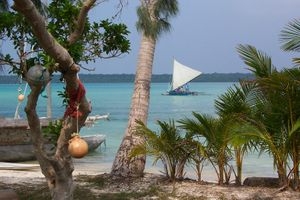
Baie de Saint-Joseph à l'Île des Pins This isolated New Caledonia from the rest of the world's landmasses, and made it a Noah's Ark of sorts, preserving a snapshot of prehistoric Gondwanan forests. The country still shelters an extraordinary diversity of unique, endemic, and extremely primitive plants and animals of Gondwanan origin. For more information on the significance of this country's flora and fauna, as well as the dangers it faces, and its effects on national social, economic, and political life, see Biodiversity of New Caledonia and Endemic Birds of New Caledonia. Although the majority of the country's citizens are unaware of the extraordinary nature of their country's biological patrimony, a few of the country's animals and plants have become somewhat emblematic in local culture. 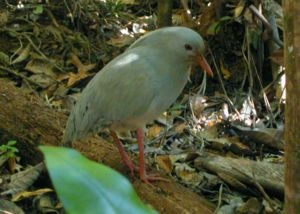
The endemic Kagu bird Its song and image are frequently seen as nationally-recognized icons. Another commonly used cultural emblem is the Columnar or Cook's Pine (Araucaria columnaris), an important symbol in Kanak culture. The Niaouli tree (also native to Australia and New Guinea), is of medicinal interest, locally and abroad. Its sap (which contains Gomenol, a camphor-smelling compound), is used to treat head colds, and as an antiseptic. It also shows potential to treat other medical ailments. Before the Europeans arrived, there was no mammal other than the Roussette (aka flying fox), a large vegetarian bat, considered a local delicacy. Less well-known by the native population is the fact their country is home to a species of plant, (Amborella trichopoda), believed to be genetically close to the ancestor of all flowering plants, or the fact their nation boasts the largest number and diversity of conifer species in the world, per unit of geographic area (a remarkable fact, given that conifers are usually relatively rare in tropical regions). 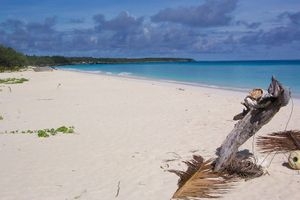
Ouvéa atoll Higher-rainfall areas (located on the Loyalty Islands, Isle of Pines (Île des Pins), and on the eastern side of Grande Terre) which support New Caledonia rain forests, and a more arid region, home to the now exceedingly-endangered New Caledonia dry forests, located in the rain shadow on the western side of Grande Terre. Europeans settled on the dry west coast of Grande Terre, leaving the east (as well as the Loyalty Islands and the Isle of Pines) to the Kanaks, and resulting in an ethno-cultural division which coincides with the natural one. Extensive farming by Europeans in the dry forest areas, has caused these forest ecosystems to virtually disappear. In addition to the remarkable terrestrial environment of New Caledonia, the country is also home to important aquatic ecosystems. Its freshwater ecology also evolved in long isolation, and the New Caledonia rivers and streams are home to many endemic species. 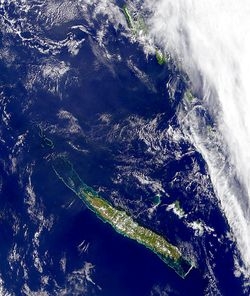 New Caledonia from space Like its terrestrial counterpart, the Caledonian reef system has great species diversity, is home to endangered dugongs (Dugong dugong), and is an important nesting site for the Green Sea Turtle (Chelonia mydas). The Nautilus is a living-fossil species, once common during the age of the dinosaurs, and survives today in the waters surrounding New Caledonia. In January 2002, the French government proposed listing New Caledonia's reefs as a UNESCO World Heritage Site. UNESCO listed New Caledonia Barrier Reef on the World Heritage List under the name The Lagoons of New Caledonia: Reef Diversity and Associated Ecosystems on 7 July 2008. Challenges posed by charting a course for the territory's racial and political life, the current government faces an additional, extraordinary challenge in balancing the needs of the territory's mining-based economy, with the protection of its globally-recognized, ecological-important wild areas. 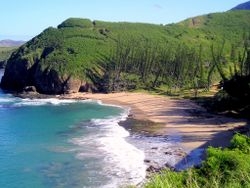 "Baie des Tortues" (Turtle Bay) near "La roche percée" (Pierced Rock) at Bourail in New Caledonia No animal dinosaurs obviously exist today, New Caledonia's flora (and, in a few cases, fauna) is extraordinarily primitive, substantially unchanged from the days of the dinosaurs, and can be found virtually nowhere else on earth outside of its small land mass. Economy New Caledonian soils contain a considerable wealth of industrially-critical elements and minerals, including about one-quarter of the world's nickel resources. Mining is therefore a significant industry that greatly benefits the territory's economy. 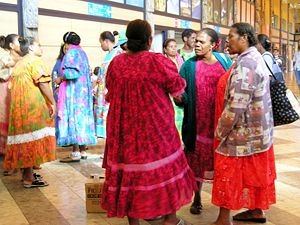 Kanak women Though still the largest group, the indigenous Melanesian Kanak community now represents 44.6% of the whole population (as of 1996 census), their proportion of the population having declined due to immigration and other factors. The rest of the population is made up of ethnic groups that arrived in New Caledonia in the last 150 years: Europeans (34.5%) (predominantly French, with German, British and Italian minorities), Polynesians (Wallisians, Tahitians) (11.8%), Indonesians (2.6%), Vietnamese (1.4%), Ni-Vanuatu (1.2%), and various other groups (3.9%), such as Malabaris and Tamils, Indians (Hindu and Muslim), Sri Lankans, Bengalis, Berbers, Japanese, Chinese, Fijians (Native Fijians and Indo- Fijian), Arabs, West Indian (mostly from other French territories) and a small number of ethnic Africans. Some of this immigration was a direct consequence of various conflicts around the world but in particular of the crumbling of the French colonial empire. 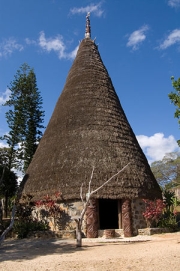 Kanak houses Similarly, those whose roots are in French Polynesia are known either as Tahitians (which excludes persons originating in the other archipelagoes of French Polynesia) or simply as Polynesians (which would include both Tahitians and Wallisians, as well as many other minor groups). Whites that have lived in New Caledonia for several generations are locally known as Caldoches, whereas newcomers who have immigrated from metropolitan France are called Métros or Métropolitains. Nationality: noun: New Caledonian(s) adjective: New Caledonian Ethnic groups: According to the 1996 census: Melanesian 44.6%, European 34.5%, Wallisian 9.1%, Tahitian 2.7%, Indonesian 2.6%, Vietnamese 1.4%, Ni-Vanuatu 1.2%, other (Filipino) 3.9% Religions: Roman Catholicism 60%, Protestantism 30%, other 10%. Languages: French (official), 33 Melanesian-Polynesian languages.  Flag used at the 2007 South Pacific Games. The most popular sport is cricket followed by football. The New Caledonia football team participates in the Oceania region's Nations Cup. Rugby league has been played in New Caledonia since 2003 when its rugby union governing body and clubs switched.
All text is available under the terms of the GNU Free Documentation License (see Copyrights for details). About Wikipedia Disclaimers
Other pages in my New Caledonia series
Site Index Back to Top Photos Index Thanks for coming, I hope you
have enjoyed it, will recommend
it to your friends, and will come
back later to see my site developing
and expanding.
|
||||||||||||||||||||||||||||||||||||||||||||||||||||||||||||||||||||||